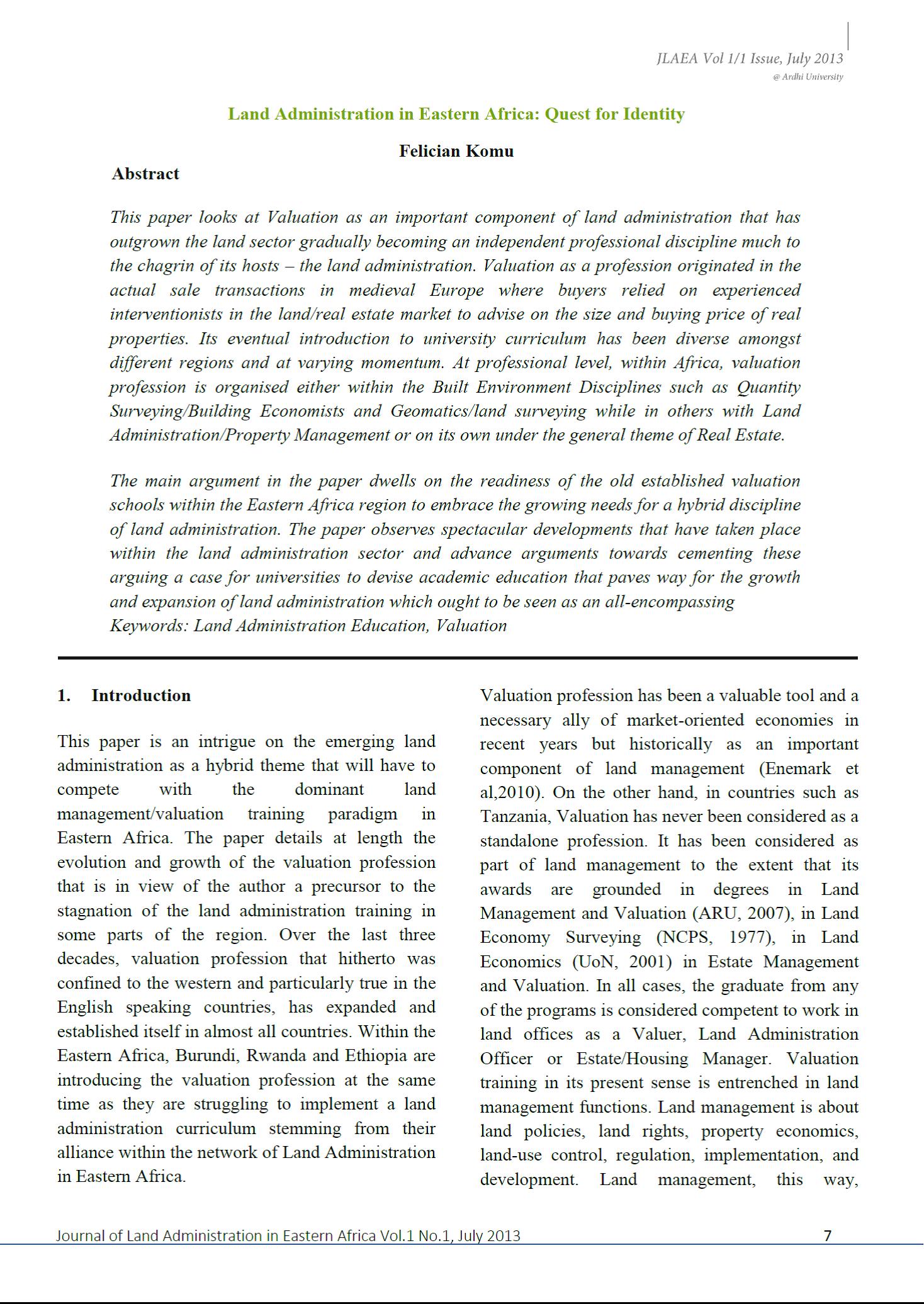Focal point
Location
The Journal of Land Administration in Eastern Africa (JLAEA) is publication of the Land Administration Unit that was set up at ARU in November 2009. JLAEA mirrors the aspirations of the Land Administration Unit at Ardhi University (ARU) whose mission is to ensure quality education and training, research, scientific publications, information dissemination, documentation and public services through integrated cross disciplinary team work in land administration. In November 2011, Ardhi University agreed to a suggestion by the newly established Eastern African Land Administration Network (EALAN) to make the Journal, a property of the network. The EALAN comprises of universities conducting education and training in land administration in Tanzania, Kenya, Uganda, Ethiopia and Rwanda.
Purpose of the Journal
The evolving need for a multi-disciplinary approach in land administration has been well captured by the United Nations institutions drawing experiences from different countries across the globe. In East Africa, land administration is increasingly becoming a crosscutting discipline and no longer limited to the mundane land allocation and use control enforcement processes. It is more diverse and anchored in information communication technology and democratic institutional systems within the land sector. For training institutions such as Ardhi University (ARU), the challenge has been to train the new brand of land administrator who will have to work with the single-discipline trained land sector specialists.
The Journal of Land Administration in Eastern Africa (JLAEA) is publication of the Land Administration Unit that was set up at ARU in November 2009. JLAEA mirrors the aspirations of the Land Administration Unit at ARU whose mission is to ensure quality education and training, research, scientific publications, information dissemination, documentation and public services through integrated cross disciplinary team work in land administration. In November 2011, Ardhi University agreed to a suggestion by the newly established Eastern African Land Administration Network (EALAN) to make the Journal, a property of the network. The EALAN comprises of universities conducting education and training in land administration in Tanzania, Kenya, Uganda, Ethiopia and Rwanda
Members:
Resources
Displaying 31 - 34 of 34Compulsory Land Acquisition in Post War Sub-Saharan Africa: Some Lessons from Burundi
Gaining access to private lands in war-torn societies is a problem that confronts many governments, including Burundi when implementing public projects. Government officials hastily acquired private lands while implementing projects which are not always for public interests. Using the case study approach, the study explored what happened when land was acquired to erect a new Presidential Palace at Gasenyi area.
Compulsory Acquisition Practices and the Determination of Compensation Payable in the Niger Delta
The right to Compensation for the compulsory acquisition of real property is constitutional and most enabling laws prescribe valuation methods to be adopted in determining the compensation payable. This paper aims at ascertaining the implications of the constitutional provisions and its impact on the compensation payable. It reviews some legislation, prescribed compensation rates and a valuation report on the Obite- Ubeta- Rumuekpe (OUR) pipeline acquisition and analyses the valuation method used.
Land Administration in Eastern Africa: Quest for Identity
This paper looks at Valuation as an important component of land administration that has outgrown the land sector gradually becoming an independent professional discipline much to the chagrin of its hosts – the land administration. Valuation as a profession originated in the actual sale transactions in medieval Europe where buyers relied on experienced interventionists in the land/real estate market to advise on the size and buying price of real properties. Its eventual introduction to university curriculum has been diverse amongst different regions and at varying momentum.
The Structure of Cadastral System in Kenya
The cadastral system2 in Kenya was established in 1903 to cater for land alienation for the white settlers. Since then, a hundred years later, the structure of the system has remained more or less the same despite major changes in surveying technology. The government of Kenya has realized that the current structure is not conducive to economic demands of the 21st century and is interested in re-organizing the structure in line with the current constitutional dispensation and new paradigms in land management.





